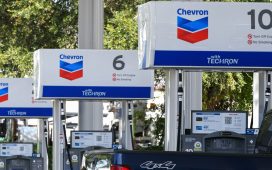Trevor Rees-Jones in the “party barn” on his ranch, fall 2015.
Matthew Mahon, for Forbes, 2015.
If the rumors are true and Dallas billionaire Trevor Rees-Jones is set to sell his Chief Oil & Gas for $2.4 billion to Chesapeake Energy — it would be the single biggest payday for the most successful shale fracker of the Great American oil and gas boom. In 2016 Forbes put Rees-Jones on the cover, highlighting what was then his seven deals in seven years for $7 billion. Forbes estimates that Rees-Jones, 70, has a net worth of $4.5 billion.
No doubt there are richer frackers, like Harold Hamm, chairman of Continental Resources
CLR
But Rees-Jones, if this deal goes through, will be unmatched in personal liquidity events. And he’s selling at a good time, with natural gas demand surging amid a global energy crisis that has the U.S. exporting record amounts (10 billion cubic feet per day) of liquefied natural gas to Europe. Prices for gas recently surged to $5 per million Btu, from a low of $1.70 in 2020. But that’s nothing compared with gas prices in Europe, where front-month futures are trading at $25/mmBtu.
Chief produces almost exclusively natural gas, from the Marcellus shale region of Pennsylvania. Ironically, if Chesapeake does buy Chief, it will be reacquiring Marcellus acreage that Rees-Jones bought from the company for $500 million back in 2013. There’s still plenty of drilling to be done on Chief’s land there. Presumably any deal would include Chief’s all-important contracts to ship its gas through regional pipelines into population centers in the Northeast.
Rees-Jones, who has been shopping Chief for months, did not respond to requests for comment on the acquisition rumors, nor did Chesapeake.
The billionaire did however host Forbes at one of his ranches in north Texas for a 2016 profile. He described starting his entrepreneurial career selling tadpoles to neighborhood kids in Dallas for a nickel. After Dartmouth he became a bankruptcy attorney. “I just couldn’t stand being a lawyer,” he says. “I found myself bored to death by the legal aspects. But I was fascinated by the oil and gas business—putting deals and prospects together.”
So in 1994 he and some partners launched Chief. In the early days he practiced wildcatting — pure exploratory drilling on a wing and a prayer, and drilled 17 dry holes in a row. “I always enjoyed playing poker,” he says. “But after I got to drilling I lost my interest in playing poker. My risk-taking was satisfied by drilling wells.”
In 2000 he followed the late oil and gas billionaire George Mitchell into drilling the Barnett shale around Fort Worth. Soon they discovered that every well they drilled hit gas, and if they “fracked” the reservoir rock by blasting it with a high-pressure mix of water and sand, they could make profitable wells, and never drill another dry hole. By 2004 Chief was the second-biggest operator in the Barnett, and Rees-Jones bought out his partners, then cut a deal with Ross Perot Jr. to drill on some of his Fort Worth land.
Then came the flood of deals. In 2006 he sold part of his Barnett position to Devon Energy
DVN
He donated $400 million to his Rees-Jones Foundation, handed over another $200 million to those former partners in a settlement. Meanwhile he had been seeking to replicate the Barnett miracle in the Marcellus shale of Pennsylvania where in 2007 he had leased up 600,000 acres. In 2009 he sold a 30% stake to Enerplus for $400 million. In 2010 Exco Resources bought 100,000 acres for $460 million. And in 2011 Chevron
CVX
From 2016.
Forbes cover
In the decade since then, Rees-Jones has put Chief largely on autopilot, drilling enough to maintain production levels at roughly 800 million cubic feet per day. An oil and gas guy through and through, Rees-Jones has been recycling cash into buying passively held royalty interests, i.e. the rights to the oil and gas in the ground and the entitlement to a royalty when they are produced. Royalty owners get the cream off the top, generally from 12% to 20% of the value of any hydrocarbons recovered, and with zero expenses.
Buying mineral rights to undrilled land can be a very long duration bet, however — you only get your royalties if someone else comes along willing to invest in drilling wells and building pipelines. Rees-Jones has said he has mineral interests in more than a million acres across the country, with an emphasis on the Permian Basin of west Texas. He preaches a long-term approach, telling me years ago. “When I was able to get down the road a ways and look back, I realized success is 90% perseverance. The key is to stay in the game.”
Meanwhile, Chesapeake is a transformed company compared with the one Rees-Jones bought those Marcellus assets from in 2013. Back then Chesapeake was still under the control of the mecurial Aubrey McClendon (d. 2016), who had borrowed massively to fund a land grab in America’s then-nascent shale plays. After years of muddling along and restructuring, Chesapeake in 2020 filed for Chapter 11, wiped out $7 billion in debt, renegotiated $15 billion in contracts.
The Chesapeake that many investors remember as hopelessly overleveraged now has a manageable $2.3 billion in debt after its August acquisition of Vine Energy. Chesapeake’s operations are now focused on Texas, Wyoming, Louisiana and Pennsylvania, where it had three rigs running last year, its most active location.
The company now expects to generate sufficient cash to pay $1 billion in dividends this year ($1.75 per share) and repurchase $1 billion in stock. Although most oil and gas stocks have been selling off this week, investors seem unenthused by rumors of a Chief deal. Chespeake shares at $63.24 are down 15% from a post-Chapter 11 high in early January, at a marketcap of $7.4 billion and implied dividend yield of 2.59%.








